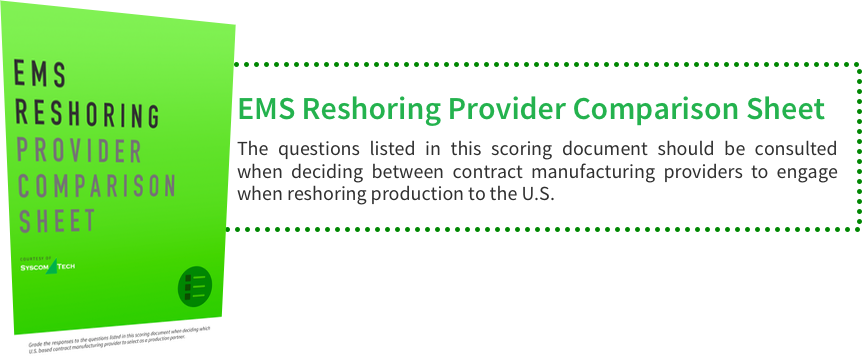In recent years, original equipment manufacturers (OEMs) have felt the mounting burden of unexpected tax liabilities – and many lack the capital to pay them off. This change began when 2013 showed unforeseen profitability and a sudden funnel of income. After spending years cutting back on taxes, a sudden need for heavy capital investment – combined with tax hikes such as the 10% jump in capital gains and the disappearance of breaks like bonus depreciation – caused many businesses owners to consider offshoring more favorable. Now, domestic manufacturing has become more advantageous, and billions of dollars’ worth of tax incentives exist for OEMs reshoring their operations to the U.S.
Several tax credits exist for OEMs reshoring their operations to U.S. Review this list of tax incentives when developing an executable reshoring plan.
Research & Development Tax Incentives
After the IRS changed its definition of “R&D” in 2001 to include almost every type of business in the manufacturing and technology sectors, R&D Tax Credit (41) has become a nearly universally accessible program. Small and medium sized enterprises, especially, may not realize how many programs they actually qualify for. Everyday activities such as CNC programming, welding, and quality assurance can qualify businesses for tax benefits.
Reshoring Tax Incentives
Domestic Production Deduction (Internal Revenue Code Section 199)
OEMs reshoring their operations can benefit from Domestic Production Deduction (199). U.S. Manufacturers with qualified production activities income (QPAI) from domestic operations – either all or in part – are entitled to a 9% deduction of their net income (not exceeding 50% of W-2 wages for the taxable year). This is a straightforward deduction that can be obtained each year by filling out IRS Form 8903.
Specialized Tax Incentives
R&D Tax Credit (Internal Revenue Code Section 41)
Manufacturers can deduct expenditures of qualifying R&D activities directed towards product improvement as current business expenses instead of capital expenses– regardless of level of the technological advancement or nature of the product. This can be done in one of two ways: deducting R&D expenses in the tax year for a nonrefundable tax credit or amortizing these costs over the course of at least 60 months.
Solar Investment Tax Credit (Internal Revenue Code Section 48)
The solar ITC offers a 30% tax credit for manufacturers that install solar energy systems on their own property or help develop/finance other solar installations. OEMs should begin these installations as soon as possible, as the credit for commercial and utility projects will drop to 26% in 2020, 22% in 2021, and permanently to 10% after 2021.
Expansion and Hiring Tax Incentives
Enterprise Zone (EZ) Tax Credits (varying by state)
To drive economic stimulation in depressed areas, most states offer a variety of subsidies including hiring credits, capital gains tax exemption, and local property tax abatements for businesses willing to expand to these areas. EZs can extend to entire cities or counties depending the individual state’s criteria, which can include factors such as unemployment rate, education level, or building vacancy rate.
Work Opportunity Tax Credit (Internal Revenue Code Section 51)
Aimed at incentivizing workplace diversity, the WOTC is an uncapped one-time federal tax credit for new hires from target groups facing significant employment barriers. It is calculated based on a percentage of qualified wages paid to individuals of these groups (as certified by the designated local agency [DLA]).
Property Tax Incentives
Cost Segregation (Internal Revenue Code 1245, 1250)
Cost segregation studies, outlined in the IRS’ Audit Techniques Guide, can yield immediate and future savings by allowing the reclassification of commercial real estate assets and costs for tax reporting. These studies identify opportunities to segregate out personal property, resulting in accelerated depreciation of commercial assets for immediate cash flow and reduced tax liability. Cost segregation audits are available to real estate owners that have built, bought, or renovated property exceeding $500,000 at purchase or $50,000 in annual property taxes in the past 20 years.
Property Tax Mitigation
Commercial property owners paying $50,000 or more per year in real and personal property taxes are eligible for property tax mitigation studies. Like cost segregation, these audits identify potential reductions or refunds to earn small business owners immediate increases in cash flow, as well as reduced tax liability for the current and future years.

